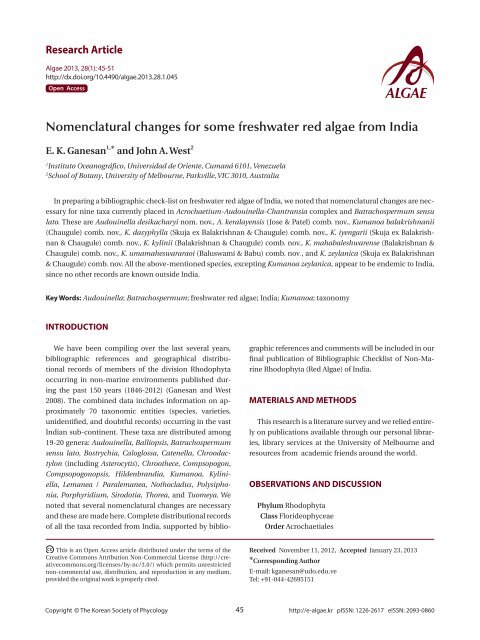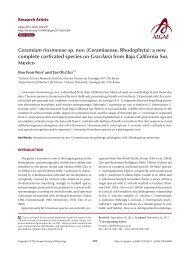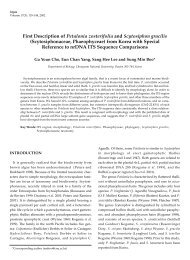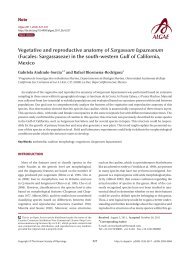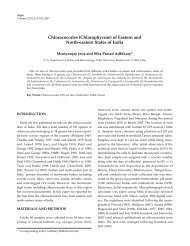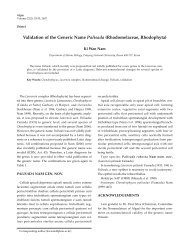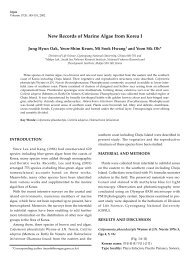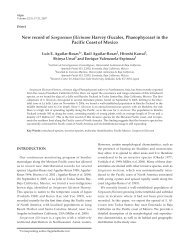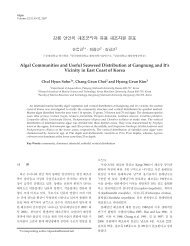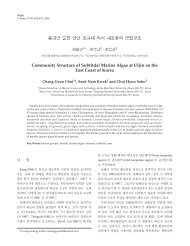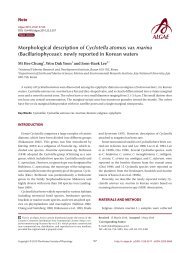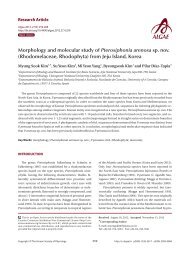Nomenclatural changes for some freshwater red algae from India
Nomenclatural changes for some freshwater red algae from India
Nomenclatural changes for some freshwater red algae from India
You also want an ePaper? Increase the reach of your titles
YUMPU automatically turns print PDFs into web optimized ePapers that Google loves.
Research Article<br />
Algae 2013, 28(1): 45-51<br />
http://dx.doi.org/10.4490/<strong>algae</strong>.2013.28.1.045<br />
Open Access<br />
<strong>Nomenclatural</strong> <strong>changes</strong> <strong>for</strong> <strong>some</strong> <strong>freshwater</strong> <strong>red</strong> <strong>algae</strong> <strong>from</strong> <strong>India</strong><br />
E. K. Ganesan 1, * and John A. West 2<br />
1 Instituto Oceanográfico, Universidad de Oriente, Cumaná 6101, Venezuela<br />
2 School of Botany, University of Melbourne, Parkville, VIC 3010, Australia<br />
In preparing a bibliographic check-list on <strong>freshwater</strong> <strong>red</strong> <strong>algae</strong> of <strong>India</strong>, we noted that nomenclatural <strong>changes</strong> are necessary<br />
<strong>for</strong> nine taxa currently placed in Acrochaetium-Audouinella-Chantransia complex and Batrachospermum sensu<br />
lato. These are Audouinella desikacharyi nom. nov., A. keralayensis (Jose & Patel) comb. nov., Kumanoa balakrishnanii<br />
(Chaugule) comb. nov., K. dasyphylla (Skuja ex Balakrishnan & Chaugule) comb. nov., K. iyengarii (Skuja ex Balakrishnan<br />
& Chaugule) comb. nov., K. kylinii (Balakrishnan & Chaugule) comb. nov., K. mahabaleshwarense (Balakrishnan &<br />
Chaugule) comb. nov., K. umamaheswararaoi (Baluswami & Babu) comb. nov., and K. zeylanica (Skuja ex Balakrishnan<br />
& Chaugule) comb. nov. All the above-mentioned species, excepting Kumanoa zeylanica, appear to be endemic to <strong>India</strong>,<br />
since no other records are known outside <strong>India</strong>.<br />
Key Words: Audouinella; Batrachospermum; <strong>freshwater</strong> <strong>red</strong> <strong>algae</strong>; <strong>India</strong>; Kumanoa; taxonomy<br />
INTRODUCTION<br />
We have been compiling over the last several years,<br />
bibliographic references and geographical distributional<br />
records of members of the division Rhodophyta<br />
occurring in non-marine environments published during<br />
the past 150 years (1846-2012) (Ganesan and West<br />
2008). The combined data includes in<strong>for</strong>mation on approximately<br />
70 taxonomic entities (species, varieties,<br />
unidentified, and doubtful records) occurring in the vast<br />
<strong>India</strong>n sub-continent. These taxa are distributed among<br />
19-20 genera: Audouinella, Balliopsis, Batrachospermum<br />
sensu lato, Bostrychia, Caloglossa, Catenella, Chroodactylon<br />
(including Asterocytis), Chroothece, Compsopogon,<br />
Compsopogonopsis, Hildenbrandia, Kumanoa, Kyliniella,<br />
Lemanea / Paralemanea, Nothocladus, Polysiphonia,<br />
Porphyridium, Sirodotia, Thorea, and Tuomeya. We<br />
noted that several nomenclatural <strong>changes</strong> are necessary<br />
and these are made here. Complete distributional records<br />
of all the taxa recorded <strong>from</strong> <strong>India</strong>, supported by biblio-<br />
This is an Open Access article distributed under the terms of the<br />
Creative Commons Attribution Non-Commercial License (http://creativecommons.org/licenses/by-nc/3.0/)<br />
which permits unrestricted<br />
non-commercial use, distribution, and reproduction in any medium,<br />
provided the original work is properly cited.<br />
graphic references and comments will be included in our<br />
final publication of Bibliographic Checklist of Non-Marine<br />
Rhodophyta (Red Algae) of <strong>India</strong>.<br />
MATERIALS AND METHODS<br />
This research is a literature survey and we relied entirely<br />
on publications available through our personal libraries,<br />
library services at the University of Melbourne and<br />
resources <strong>from</strong> academic friends around the world.<br />
OBSERVATIONS AND DISCUSSION<br />
Phylum Rhodophyta<br />
Class Florideophyceae<br />
Order Acrochaetiales<br />
Received November 11, 2012, Accepted January 23, 2013<br />
*Corresponding Author<br />
E-mail: kganesan@udo.edu.ve<br />
Tel: +91-044-42695151<br />
Copyright © The Korean Society of Phycology 45 http://e-<strong>algae</strong>.kr pISSN: 1226-2617 eISSN: 2093-0860
Algae 2013, 28(1): 45-51<br />
Family Acrochaetiaceae<br />
Genus Audouinella Bory de Saint-Vincent emend.<br />
Harper & Saunders 2002<br />
Audouinella desikacharyi E. K. Ganesan & J.<br />
A. West nom. nov.<br />
Basionym. Chantransia pulvinata Schmidle 1900, p. 79.<br />
Homotypic synonym. Audouinella pulvinata (Schmidle)<br />
Desikachary, Balakrishnan & Krishnamurthy 1990, p.<br />
75; Silva 2012; non Audouinella pulvinata (Levring) Garbary<br />
1987, p. 145.<br />
Comments. Pending critical morphometric and molecular<br />
studies on Audouinella species known <strong>from</strong> <strong>India</strong>,<br />
we treat tentatively all <strong>freshwater</strong> species with an “acrochaetioid”<br />
morphology in a broad sense (i.e., bluish and /<br />
or <strong>red</strong>dish in color, with a single or multiple plastids, with<br />
or without pyrenoids and with or without asexual / sexual<br />
reproduction) under a single generic name (see also<br />
Harper and Saunders 2002). The <strong>India</strong>n species was described<br />
<strong>for</strong> the first time by Schmidle (1900) as Chantransia<br />
pulvinata Schmidle <strong>from</strong> <strong>freshwater</strong> (Matheran; Ponsonby<br />
Spring falls, Lake Danger Point, growing on stones)<br />
in Maharashtra state of Western Ghats, <strong>India</strong>. According<br />
to Stafleu and Cowan’s Tax. Lit. II, Schmidle’s herbarium<br />
is in Zurich herbarium (ZT), Switzerland (Michael J. Wynne<br />
personal communication), which “probably” houses<br />
the original collection made <strong>from</strong> <strong>India</strong>. Desikachary et<br />
al. (1990) transfer<strong>red</strong> C. pulvinata to Audouinella as A.<br />
pulvinata (Schmidle) Desikachary, Balakrishnan & Krishnamurthy<br />
and possibly based on the description given<br />
by De Toni (1905), provided an English description translated<br />
<strong>from</strong> the German protologue. The characteristic<br />
feature of the species, apart <strong>from</strong> the small pulvinate and<br />
heterotrichous habit, is the torulose nature of the cells of<br />
the discoid base. Much earlier, Levring (1953, p. 477, Fig.<br />
12A-F) described and illustrated as new, a marine species,<br />
<strong>from</strong> Australia as Acrochaetium pulvinatum, which<br />
Garbary (1987) transfer<strong>red</strong> to the genus Audouinella as<br />
A. pulvinata (Levring) Garbary (1987, p. 145). Hence, as<br />
a later homonym, but referring to an entirely different<br />
taxon occurring in <strong>freshwater</strong>s of <strong>India</strong>, the combination<br />
made by Desikachary et al. (1990) is illegitimate (Silva<br />
2012). Consequently, we here propose a new name, Audouinella<br />
desikacharyi <strong>for</strong> the <strong>India</strong>n <strong>freshwater</strong> species<br />
honouring the late Professor T. V. Desikachary. No collection<br />
other than the original one is known.<br />
Chantransia (also Pseudochantransia) as generic<br />
names, are not generally in current usage, but simply<br />
treated as <strong>for</strong>m-genera, <strong>for</strong>m-taxa or genera incertae sedis<br />
(Vis et al. 2006, Chiasson et al. 2007, Schneider and Wyn-<br />
http://dx.doi.org/10.4490/<strong>algae</strong>.2013.28.1.045 46<br />
ne 2007). More importantly, Chantransia spp. are conside<strong>red</strong><br />
as phases in the life-cycle of genera belonging to different<br />
orders like Acrochaetiales, Batrachospermales, and<br />
Thoreales (Pueschel et al. 2000, Necchi and Jiménez 2002,<br />
Zucchi and Necchi 2003, Chiasson et al. 2005, 2007, Necchi<br />
and Oliveira 2011). Chiasson et al. (2007) demonstrated,<br />
by molecular data and culture studies, that the <strong>for</strong>m<br />
taxon Chantransia pygmaea is “unequivocally associated<br />
with five different taxa among three genera”: 1) ‘Batrachospermum<br />
ambiguum, (currently referable to Kumanoa<br />
ambigua [Montagne] Entwisle, Vis, Chiasson, Necchi &<br />
Sherwood), B. arcuatum Kylin, and B. atrum (Hudson)<br />
Harvey, 2) Nemalionopsis tortuosa Yoneda & Yagi, and 3)<br />
Thorea violacea Bory de Saint-Vincent. On the other hand,<br />
they have pointed out earlier (Chiasson et al. 2005) and<br />
confirmed recently (see Pueschel et al. 2000, Necchi and<br />
Oliveira 2011) that Chantransia macrospora consituted<br />
the alternate phase <strong>for</strong> a single species (B. macrosporum<br />
Montagne), although other species of Batrachospermum<br />
were also present in the same stream. Necchi and Oliveira<br />
(2011) recently showed that “Chantransia pygmaea” is associated<br />
with 7 species of the Batrachospermales and 2<br />
species of Thoreales. Hence, caution should be exercised<br />
in relating one Chantransia species with one or several<br />
Batrachospermum species occurring in the same water<br />
body. It is pointed out that A. desikacharyi (=C. pulvinata<br />
Schmidle) was collected <strong>from</strong> Matheran in Maharashtra<br />
state where Kumanoa kylinii (Balakrishnan & Chaugule)<br />
E. K. Ganesan & J. A. West (=Batrachospermum kylinii<br />
Balakrishnan & Chaugule see below) was also collected.<br />
Hence, A. desikacharyi may or may not be associated with<br />
the Chantransia phase of K. kylinii, which can be clarified<br />
by culture studies with molecular analysis.<br />
Audouinella keralayensis (Jose & Patel) E. K. Ganesan<br />
& J. A. West comb. nov.<br />
Basionym. Acrochaetium keralayensis Jose & Patel<br />
1990, p. 179.<br />
Comments. This species was collected <strong>from</strong> Periyar<br />
river, near Alwaye, Kerala, <strong>India</strong> and is a notable omission<br />
in Kumano (2002). It is currently treated as Acrochaetium<br />
in AlgaeBase (Guiry and Guiry 2012), while it does not<br />
appear in Index Nominum Algarum (INA) database (Silva<br />
2012) either under Acrochaetium or Audouinella. Ott<br />
(2009) treated it under Psuedochantransia as P. keralayensis<br />
(Jose & Patel) Ott. Jose and Patel (1990) provided a<br />
Latin diagnosis and also designated the Holotype (C, No.<br />
K 20) at the Department of Biosciences, Sardar Patel University,<br />
VallabhVidyanagar, Gujarat, <strong>India</strong>.
Order Batrachospermales<br />
Family Batrachospermaceae<br />
Genus Kumanoa Entwisle, Vis, Chiasson, Necchi &<br />
Sherwood 2009<br />
Entwisle et al. (2009) segregated Batrachospermum<br />
species <strong>from</strong> the sections Contorta and Hybrida to a new<br />
genus Kumanoa. Vis et al. (2012) initially recognized 31<br />
species of Kumanoa, but in a recent monograph, Necchi<br />
and Vis (2012) recognized 35 species worldwide. In the<br />
most recent update AlgaeBase (Guiry and Guiry 2012), 43<br />
binomials are cited under Kumanoa, of which 6 names<br />
are conside<strong>red</strong> synonyms, thus making a total of 37 species<br />
names at present. Necchi and Vis (2012) in their<br />
monograph listed 12 species as “doubtful” members of<br />
Kumanoa, because of “the unavailability of type specimen<br />
or descriptions missing key diagnostic characters<br />
presently used to delineate species reliably.” Of these 12<br />
doubtful species listed by Necchi and Vis (2012), 5 species<br />
were described based on specimens collected <strong>from</strong> <strong>India</strong>.<br />
Based on published in<strong>for</strong>mation available to us, we here<br />
reconfirm the status of these 5 “uncertain” species, and<br />
also add 2 more species described <strong>from</strong> <strong>India</strong> as belonging<br />
to Kumanoa. Kumanoa was characterized by certain<br />
features like 1) twisted or coiled nature of the carpogonial<br />
branches and axial position of compact carposporophytes<br />
and 2) molecular data <strong>for</strong>ming a well-supported clade<br />
distinct <strong>from</strong> other sections of the genus based on rbcL<br />
and small subunit of ribosomal gene sequences (Entwisle<br />
et al. 2009). Other recent studies (Necchi et al. 2010, Vis et<br />
al. 2012) revealed that molecular data do not support any<br />
further infrageneric categories under Batrachospermum<br />
sensu lato. From a distributional point of view, species<br />
of Kumanoa are more commonly reported <strong>from</strong> tropical<br />
and subtropical latitudes and strictly <strong>from</strong> <strong>freshwater</strong><br />
environments like Batrachospermum. It is becoming<br />
increasingly clear that the twisted or contorted nature<br />
of the carpogonial branches and the central position of<br />
the carposporophyte are easily recognizable features to<br />
distinguish Kumanoa <strong>from</strong> Batrachospermum species<br />
sensu lato <strong>from</strong> different regions of the world (Liao 2010,<br />
Eloranta et al. 2011, Goodman 2011). It is also relevant to<br />
point out that other genera like Nothocladus, Sirodotia<br />
and Tuomeya, which are closely related to both Batrachospermum<br />
and Kumanoa, share <strong>some</strong> female reproductive<br />
structures like: 1) symmetrical or asymmetrical nature of<br />
(long or short) the carpogonial branch and 2) diffuse or<br />
non-compact carposporophytes creeping among cortical<br />
filaments. While studying the literature on the 17 Batra-<br />
Ganesan & West <strong>India</strong>n Freshwater Red Algae<br />
chospermum sensu lato species records <strong>from</strong> <strong>India</strong>, we<br />
found that 7 species have been clearly described and illustrated<br />
to have twisted or curled carpogonial branches<br />
and axial or nodal position of the carposporophytes and<br />
hence we transfer them to Kumanoa. Critical molecular<br />
studies on <strong>India</strong>n <strong>freshwater</strong> <strong>red</strong>s will be needed conclusively<br />
to confirm (or reject) our transfers to Kumanoa, but<br />
to facilitate communication and documentation of the<br />
known algal flora of <strong>India</strong>, we conside<strong>red</strong> it reasonable to<br />
make a number of proposals here. Of the 7 species of Kumanoa<br />
reported here, except K. zeylanica recorded both<br />
in Sri Lanka and <strong>India</strong>, 6 species are known <strong>from</strong> the original<br />
or a few other collections in <strong>India</strong>, but mostly <strong>from</strong><br />
the same place of occurrence. Without substantial further<br />
investigations on their distribution patterns in different<br />
parts of <strong>India</strong> and other regions, it is difficult to assess<br />
as to whether <strong>some</strong> of the <strong>India</strong>n Kumanoa species are<br />
“robust” or “frail” endemics (Tyler 1996). Molecular data<br />
are very useful not only <strong>for</strong> precise identification, but also<br />
<strong>for</strong> evaluating inter and intra specific affinities between<br />
populations and ultimately <strong>for</strong> phylogenetic and phylogeographic<br />
evaluation. As far as we could verify, there are<br />
no molecular sequence data studies on any of the <strong>India</strong>n<br />
<strong>freshwater</strong> <strong>red</strong> algal taxa.<br />
Kumanoa balakrishnanii (Chaugule) E. K. Ganesan<br />
& J. A. West comb. nov.<br />
Basionym. Batrachospermum balakrishnanii Chaugule<br />
1980, p. 7.<br />
Comments. Chaugule (1980, Figs 13, 14 & 17) showed<br />
clearly the characteristic twisted nature of the carpogonial<br />
branches, 9-14 cells long, with “2-3 compact helices”<br />
and the axial nature of the carpopsporophyte. Hence,<br />
this species should be refer<strong>red</strong> to the genus Kumanoa.<br />
In describing the new species collected <strong>from</strong> a stream at<br />
Kas, Satara district, Maharashtra, <strong>India</strong>, Chaugule (1980)<br />
provided a Latin diagnosis and “probably” deposited the<br />
Holotype specimen in the Herbarium of the University of<br />
Pune, Pune, Maharashtra, <strong>India</strong>. We were unsuccessful to<br />
obtain the Holotype specimen <strong>for</strong> our study. This species<br />
was not mentioned by Kumano (2002), Ott (2009), INA<br />
(Silva 2012), and AlgaeBase (Guiry and Guiry 2012), probably<br />
because the description was published in a regional<br />
journal of limited circulation within <strong>India</strong> and abroad.<br />
Necchi and Vis (2012) did not include this species either<br />
under valid or doubtful taxa in their monographic study<br />
of Kumanoa.<br />
47 http://e-<strong>algae</strong>.kr
Algae 2013, 28(1): 45-51<br />
Kumanoa dasyphylla (Skuja ex Balakrishnan &<br />
Chaugule) E. K. Ganesan & J. A. West comb. nov.<br />
Basionym. Batrachospermum dasyphyllum Skuja ex<br />
Balakrishnan & Chaugule 1980a, p. 230.<br />
Comments. Considering that it was a manuscript<br />
name given by Skuja, Balakrishnan and Chaugule (1980b)<br />
examined the Holotype material borrowed <strong>from</strong> the Herbarium,<br />
Uppsala, Sweden and validated the species with<br />
a detailed description with figures and Latin diagnosis.<br />
Balakrishnan and Chaugule (1980b, Figs 4 & 7) described<br />
and illustrated the characteristic features attributed to<br />
Kumanoa, like the spirally twisted carpogonial branches<br />
and axial position of the carposporophyte, characteristic<br />
features attributed to Kumanoa. This species is known so<br />
far <strong>from</strong> <strong>India</strong> by the single original collection made by<br />
Iyengar in 1930. Necchi and Vis (2012) included B. dasyphyllum<br />
under the list of “doubtful species” of Kumanoa<br />
because the type specimen was not available <strong>for</strong> their<br />
study. The specific epithet is corrected here to dasyphylla<br />
<strong>from</strong> dasyphyllum according to Latin grammar.<br />
Kumanoa iyengarii (Skuja ex Balakrishnan &<br />
Chaugule) E. K. Ganesan & J. A. West comb. nov.<br />
Basionym. Batrachospermum iyengarii Skuja ex Balakrishnan<br />
& Chaugule 1980a, p. 232.<br />
Comments. Balakrishnan and Chaugule (1980a) described<br />
the two diagnostic features of Kumanoa 1) “carpogonial<br />
branches are comparatively long, with 13-17<br />
barrel-shaped cells and spirally twisted” (Balakrishnan<br />
and Chaugule 1980a, Fig. 12) and 2) carposporophyte<br />
(Balakrishnan and Chaugule 1980a, Fig. 13) is axial in<br />
position. Hence, this species should be transfer<strong>red</strong> to Kumanoa.<br />
The authors provided a Latin diagnosis and also<br />
designated a Lectotype (Iyengar no. IB 80, coll. Iyengar,<br />
1930) (Balakrishnan and Chaugule 1980a, see also Kumano<br />
2002). Both INA (Silva 2012) and AlgaeBase (Guiry<br />
and Guiry 2012) treated this taxon as valid and currently<br />
accepted in their respective databases, but under Batrachospermum<br />
(as B. iyengarii). Necchi and Vis (2012) were<br />
unable to obtain the Holotype specimen and justifiably<br />
included it under “doubtful” species.<br />
Kumanoa kylinii (Balakrishnan & Chaugule) E. K.<br />
Ganesan & J. A. West comb. nov.<br />
Basionym. Batrachospermum kylinii Balakrishnan &<br />
Chaugule 1980b, p. 298.<br />
http://dx.doi.org/10.4490/<strong>algae</strong>.2013.28.1.045 48<br />
Comments. The description and figures by Balakrishnan<br />
and Chaugule (1980b, Figs 3 & 9) clearly suggest that<br />
this entity should be transfer<strong>red</strong> to Kumanoa. It is a valid<br />
and taxonomically accepted species (Kumano 2002, Guiry<br />
and Guiry 2012, Silva 2012) but included under the genus<br />
Batrachospermum, as B. kylinii. Necchi and Vis (2012),<br />
because of the non-availability of the type specimen<br />
<strong>for</strong> their monographic studies, included it as a doubtful<br />
member of Kumanoa.<br />
Kumanoa mahabaleshwarense (Balakrishnan &<br />
Chaugule) E. K. Ganesan & J. A. West comb. nov.<br />
Basionym. Batrachospermum mahabaleshwarensis<br />
Balakrishnan & Chaugule 1980a, p. 231.<br />
Comments. Balakrishnan and Chaugule (1980a) described<br />
and illustrated the carpogonial branches as 3-38<br />
cells long, spirally twisted and occasionally curved with<br />
carposporophytes axial in position. Hence, this species<br />
clearly belongs to Kumanoa and the transfer is made<br />
here. The Holotype (BBC 102, coll. Balakrishnan in 1962)<br />
was deposited at the Herbarium, University of Pune, Maharashtra,<br />
<strong>India</strong> (Balakrishnan and Chaugule 1980a, p.<br />
232; Kumano 2002, p. 219). INA (Silva 2012) and Algae-<br />
Base (Guiry and Guiry 2012) included it as a valid and<br />
taxonomically accepted species, but under the genus<br />
Batrachospermum as B. mahabaleshwarense. Necchi and<br />
Vis (2012), because of the non-availability of the Holotype<br />
specimen, included it as a doubtful species of Kumanoa.<br />
The specific epithet ‘mahabaleshwarensis’ had been<br />
already corrected to mahabaleshwarense in INA (Silva<br />
2012).<br />
Kumanoa umamaheswararaoi (Baluswami &<br />
Babu) E. K. Ganesan & J. A. West comb. nov.<br />
Basionym. Batrachospermum umamaheswararaoi<br />
Baluswami & Babu 1999, p. 247.<br />
Comments. Baluswami and Babu (1999, Figs 10, 11<br />
& 20) described and illustrated carpogonial branches in<br />
B. umamaheswararaoi as up to 6 cells long and spirally<br />
coiled with carposporophytes axial in position and hence<br />
it should be transfer<strong>red</strong> to Kumanoa, as the genus is currently<br />
circumscribed. The Holotype specimen (No. 2A)<br />
was stated to have been deposited in the Laboratory of<br />
Phycology, Department of Botany, Madras Christian College,<br />
Chennai, <strong>India</strong>. Baluswami and Babu (1990) apparently<br />
based their observations on a single collection<br />
made by Azhakanandam in 1990 and this species has not
een reported again. Although it is a validly published<br />
species, it is not included either in Kumano (2002), INA<br />
(Silva 2012), or AlgaeBase (Guiry and Guiry 2012). The<br />
description of this species was apparently over-looked<br />
because it appea<strong>red</strong> in a publication that was not readily<br />
available outside of <strong>India</strong>. Necchi and Vis (2012) did not<br />
include this species either under valid or doubtful taxa<br />
in their monographic study of Kumanoa. Members of<br />
Batrachospermum sensu lato are reported commonly in<br />
the tropical regions, <strong>from</strong> low to high altitude hill streams<br />
with running and clear waters, especially during the<br />
cooler months of the year. This <strong>India</strong>n species occurs in a<br />
habitat, uncommon <strong>for</strong> most species of the genus, e.g., a<br />
small, enclosed and stagnant road-side <strong>freshwater</strong> pond<br />
with abundant macrophyte vegetation. Some species like<br />
Batrachospermum dornense Tarnavschi & Radulescu do<br />
occur in specialized habitats like peat bogs in the northern<br />
hemisphere (Caraus 2002).<br />
Kumanoa zeylanica (Skuja ex Balakrishnan &<br />
Chaugule) E. K. Ganesan & J. A. West comb. nov.<br />
Basionym. Batrachospermum zeylanicum Skuja ex Balakrishnan<br />
& Chaugule 1980a, p. 235.<br />
Comments. Balakrishnan and Chaugule (1980a) described<br />
and illustrated the characteristic features 1) the<br />
carpogonial branches spirally twisted or contorted to 13<br />
cells, (Balakrishnan and Chaugule 1980a, Fig. 14) and<br />
2) axial carposporophyte (Balakrishnan and Chaugule<br />
1980a, Fig. 16). Hence it clearly belongs to the genus Kumanoa.<br />
It is a valid and taxonomically accepted species<br />
(as B. zeylanicum) both in INA (Silva 2012) and AlgaeBase<br />
(Guiry and Guiry 2012). The type locality of this species<br />
is not clear. According to Kumano (2002), it is Jog Falls,<br />
Karnataka state, <strong>India</strong>. However, INA (Silva 2012) mentioned<br />
it to be “Kalulara” (correct spelling is Kalutara and<br />
not “Kalulara”) in Sri Lanka (<strong>for</strong>merly Ceylon). The specimen<br />
was collected by W. Ferguson and the Lectotype is<br />
specimen no. 1, NS 238 in Uppsala University Herbarium<br />
(UPS). Balakrishnan and Chaugule (1980a) made their<br />
observations on this species using specimens collected<br />
by Iyengar in 1926 <strong>from</strong> Jog Falls, Karnataka state. Given<br />
the uncertainities of correct identifications of specimens<br />
<strong>from</strong> different locales, it is difficult to know if these two<br />
collections are of same entity. Necchi and Vis (2012, p. 73)<br />
included this species as a doubtful member of Kumanoa,<br />
since type specimen was not available <strong>for</strong> their studies.<br />
The specific epithet is corrected here <strong>from</strong> zeylanicum to<br />
zeylanica according to Latin grammar.<br />
CONCLUSION<br />
Ganesan & West <strong>India</strong>n Freshwater Red Algae<br />
<strong>Nomenclatural</strong> <strong>changes</strong> were made <strong>for</strong> nine taxa occurring<br />
in <strong>India</strong> and currently placed in Acrochaetium-<br />
Audouinella-Chantransia complex and Batrachospermum<br />
sensu lato: Audouinella desikacharyi nom. nov.,<br />
A. keralayensis (Jose & Patel) comb. nov., Kumanoa balakrishnanii<br />
(Chaugule) comb. nov., K. dasyphylla (Skuja<br />
ex Balakrishnan & Chaugule) comb. nov., K. iyengarii<br />
(Skuja ex Balakrishnan & Chaugule) comb. nov., K. kylinii<br />
(Balakrishnan & Chaugule) comb. nov., K. mahabaleshwarense<br />
(Balakrishnan & Chaugule) comb. nov., K. umamaheswararaoi<br />
(Baluswami & Babu) comb. nov., and K.<br />
zeylanica (Skuja ex Balakrishnan & Chaugule) comb. nov.<br />
All the above-mentioned species, excepting Kumanoa<br />
zeylanica, appear to be endemic to <strong>India</strong>. Further investigations<br />
on these and other <strong>freshwater</strong> <strong>red</strong> <strong>algae</strong> in <strong>India</strong><br />
are in progress.<br />
ACKNOWLEDGEMENTS<br />
We are thankful to Drs. M. J. Wynne, M. L. Vis., O. Necchi<br />
Jr. and M. D. Guiry, <strong>for</strong> their helpful suggestions in the<br />
preparation of the manuscript. The Infotrieve interlibrary<br />
loan program at the Baillieu Library, University of Melbourne,<br />
Parkville, Victoria, Australia is especially thanked<br />
<strong>for</strong> their continued ef<strong>for</strong>ts in getting photocopies of several<br />
early papers on <strong>freshwater</strong> <strong>red</strong> <strong>algae</strong> <strong>from</strong> <strong>India</strong> and<br />
other places.<br />
REFERENCES<br />
Balakrishnan, M. S. & Chaugule, B. B. 1980a. <strong>India</strong>n Batrachospermaceae.<br />
In Desikachary, T. V. & Raja Rao, T. N.<br />
(Eds.) Taxonomy of Algae. University of Madras, Madras,<br />
pp. 223-248.<br />
Balakrishnan, M. S. & Chaugule, B. B. 1980b. Morphology<br />
and life-history of Batrachospermum kylinii nov. sp. J.<br />
<strong>India</strong>n Bot. Soc. 59:291-300.<br />
Baluswami, M. & Babu, M. 1999. The structure and reproduction<br />
of Batrachospermum umamaheswararaoi sp.<br />
nov. In Subbarangiah, G. (Ed.) Recent Trends in Algal Research.<br />
Andhra University, Waltair, pp. 245-254.<br />
Caraus, I. 2002. The <strong>algae</strong> of Romania. Studii si Cercetari,<br />
Universitatea Bacau, Biologie 7:1-694.<br />
Chaugule, B. B. 1980. Morphology and life history of a new<br />
species of Batrachospermum <strong>from</strong> Kas (Maharashtra).<br />
49 http://e-<strong>algae</strong>.kr
Algae 2013, 28(1): 45-51<br />
Maharashtra Viswa Mahavidyalaya (M. V. M.) Patrika<br />
15:1-8.<br />
Chiasson, W. B., Johanson, K. G., Sherwood, A. R. & Vis, M.<br />
L. 2007. Phylogenetic affinities of the <strong>for</strong>m taxon Chantransia<br />
pygmaea (Rhodophyta) specimens <strong>from</strong> the Hawaiian<br />
Islands. Phycologia 46:257-262.<br />
Chiasson, W. B., Sabo, N. J. & Vis, M. L. 2005. Affinities of<br />
<strong>freshwater</strong> putative Chantransia stages (Rhodophyta)<br />
<strong>from</strong> molecular and morphological data. Phycologia<br />
44:163-168.<br />
Desikachary, T. V., Krishnamurthy, V. & Balakrishnan, M. S.<br />
1990. Rhodophyta. Part IIA. Madras Science Foundation,<br />
Madras, 279 pp.<br />
De Toni, G. B. 1905. Sylloge algarum omnium hucusque cognitarum.<br />
Vol. IV, Florideae. Sectio II. Typis Seminarii, Patavii<br />
[Padova], pp. 1523-1973.<br />
Eloranta, P., Kwandrans, J. & Kusel-Fetzmann, E. 2011. Rhodophyceae<br />
and Phaeophyceae. In Schagerl, M. (Ed.)<br />
Süßwasserflora von Mitteleuropa [Freshwater Flora of<br />
Central Europe]. Vol. 7. Spectrum Akademischer Verlag,<br />
Heidelberg, pp. 1-155.<br />
Entwisle, T. J., Vis, M. L., Chiasson, W. B., Necchi, O. Jr. & Sherwood,<br />
A. R. 2009. Systematics of the Batrachospermales<br />
(Rhodophyta): a synthesis. J. Phycol. 45:704-715.<br />
Ganesan, E. K. & West, J. A. 2008. Updating the <strong>freshwater</strong> <strong>red</strong><br />
algal records of <strong>India</strong>. In 5th Asia-Pacific Phycol. Forum,<br />
Wellington, p. 80.<br />
Garbary, D. J. 1987. The Acrochaetiaceae (Rhodophyta): an<br />
annotated bibliography. Bibl. Phycol. 77:1-267.<br />
Goodman, K. M. 2011. Freshwater <strong>red</strong> <strong>algae</strong> use activated<br />
chemical defenses against herbivores. M.S. thesis, Georgia<br />
Institute of Technology, Atlanta, GA, USA, 41 pp.<br />
Guiry, M. D. & Guiry, G. M. 2012. AlgaeBase. World-wide<br />
electronic publication, National University of Ireland,<br />
Galway. Available <strong>from</strong>: http://www.<strong>algae</strong>base.org. Accessed<br />
Nov 5, 2012.<br />
Harper, J. T. & Saunders, G. W. 2002. A reclassification of the<br />
Acrochaetiales based on molecular and morphological<br />
data, and establishment of the Colaconematales ord.<br />
nov. (Florideophyceae, Rhodophyta). Eur. J. Phycol.<br />
37:463-476.<br />
Jose, L. & Patel, R. J. 1990. A new fresh water species of Acrochaetium<br />
(Acrochaetium keralayensis sp. nov.) <strong>from</strong><br />
<strong>India</strong>. <strong>India</strong>n Bot. Contactor (IBC) 7:177-180.<br />
Kumano, S. 2002. Freshwater <strong>red</strong> <strong>algae</strong> of the world. Biopress,<br />
Bristol, 375 pp.<br />
Levring, T. 1953. The marine <strong>algae</strong> of Australia. I. Rhodophyta:<br />
Goniotrichales, Bangiales and Nemalionales. Arkiv.<br />
Bot. 2:457-530.<br />
http://dx.doi.org/10.4490/<strong>algae</strong>.2013.28.1.045 50<br />
Liao, L. M. 2010. <strong>Nomenclatural</strong> notes on <strong>some</strong> Philippine<br />
species of <strong>freshwater</strong> <strong>red</strong> <strong>algae</strong> (Rhodophyta). Philipp. J.<br />
Syst. Biol. 4:89-94.<br />
Necchi, O. Jr. & Jiménez, J. C. 2002. Somatic meiosis and de-<br />
velopment of the juvenile gametophyte in members of<br />
the Batrachospermales sensu lato (Rhodophyta). Phycologia<br />
41:340-347.<br />
Necchi, O. Jr. & Oliveira, M. C. 2011. Phylogenetic affinities of<br />
“Chantransia” stages in members of the Batrachospermales<br />
and Thoreales (Rhodophyta). J. Phycol. 47:680-<br />
686.<br />
Necchi, O. Jr. & Vis, M. L. 2012. Monograph of the genus Kumanoa<br />
(Rhodophyta, Batrachospermales). Bibl. Phycol.<br />
116:1-79.<br />
Necchi, O. Jr., Vis, M. L. & Oliveira, M. C. 2010. Phylogenetic<br />
relationships in Kumanoa (Batrachospermales, Rhodophyta)<br />
species in Brazil with the proposal of Kumanoa<br />
amazonensis sp. nov. Phycologia 49:97-103.<br />
Ott, F. D. 2009. Handbook of the taxonomic names associated<br />
with the non-marine Rhodophycophyta. J. Cramer,<br />
Stuttgart, 969 pp.<br />
Pueschel, C. M., Saunders, G. W. & West, J. A. 2000. Affinities<br />
of the <strong>freshwater</strong> <strong>red</strong> alga Audouinella macrospora<br />
(Florideophyceae, Rhodophyta) and related <strong>for</strong>ms<br />
based on SSU rRNA gene sequence analysis and pit plug<br />
ultrastructure. J. Phycol. 36:433-440.<br />
Schmidle, W. 1900. Algologische Notizen. XIV. Einige neue<br />
von Professor Dr. Hansgirg in Vorderindien gesammelte<br />
Süsswasseralgen. Allg. Bot. Z. Syst. Florist. Pflanzengeogr.<br />
6:77-79.<br />
Schneider, C. W. & Wynne, M. J. 2007. A synoptic review of<br />
the classification of <strong>red</strong> algal genera a half century after<br />
Kylin’s “Die Gattungen der Rhodophyceen”. Bot. Mar.<br />
50:197-249.<br />
Silva, P. C. 2012. Index Nominum Algarum (INA) and Bibliographia<br />
Phycologica Universalis (BPU). University<br />
Herbarium, University of Cali<strong>for</strong>nia, Berkeley. Compiled<br />
and maintained by Paul C. Silva at the Herbarium of the<br />
University of Cali<strong>for</strong>nia. Available <strong>from</strong>: http://ucjeps.<br />
berkeley.edu/INA. Accessed Nov 5, 2012.<br />
Tyler, P. A. 1996. Endemism in <strong>freshwater</strong> <strong>algae</strong> with special<br />
reference to the Australian region. Hydrobiologia<br />
336:127-135.<br />
Vis, M. L., Entwisle, T. J., West, J. A. & Ott, F. D. 2006. Ptilothamnion<br />
richardsii (Rhodophyta) is a Chantransia<br />
stage of Batrachospermum. Eur. J. Phycol. 41:125-130.<br />
Vis, M. L., Necchi, O. Jr., Chiasson, W. B. & Entwisle, T. J. 2012.<br />
Molecular phylogeny of the genus Kumanoa (Batrachospermales,<br />
Rhodophyta). J. Phycol. 48:750-758.
Zucchi, M. R. & Necchi, O. Jr. 2003. Blue-greenish acrochaeti-<br />
oid <strong>algae</strong> in <strong>freshwater</strong> habitats are “Chantransia” stages<br />
of Batrachospermales sensu lato (Rhodophyta). Cryptogam.<br />
Algol. 24:117-131.<br />
Ganesan & West <strong>India</strong>n Freshwater Red Algae<br />
51 http://e-<strong>algae</strong>.kr


